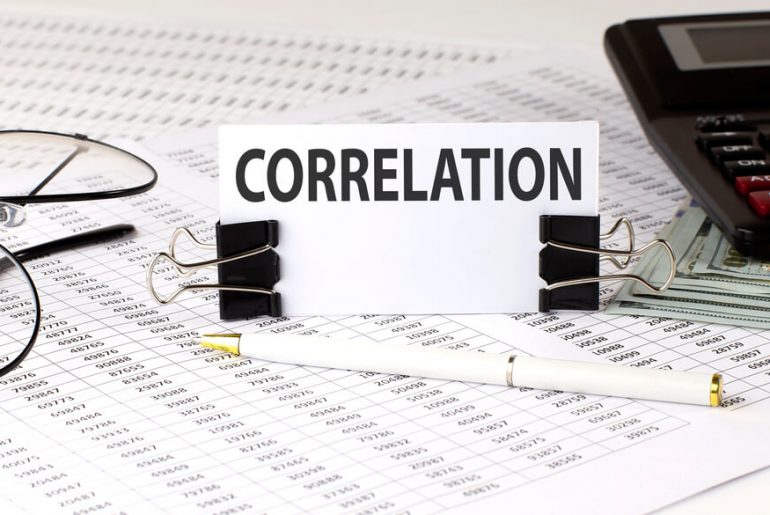In the financial markets, traders constantly seek an edge to enhance their decision-making and improve profitability. One of the most effective tools for understanding market dynamics is correlation analysis. Correlation measures the relationship between two or more assets, helping traders identify trading opportunities, manage risk, and diversify portfolios effectively.
Understanding correlation can help traders avoid redundant trades, detect market anomalies, and develop robust strategies. In this guide, we will explore the fundamentals of correlation in trading, the different types of correlations, how to calculate them, and practical applications in various trading strategies.
What is Correlation in Trading?
Correlation in trading refers to the statistical relationship between two financial instruments. It measures the degree to which the price movements of one asset are associated with those of another. Correlation is typically expressed using the correlation coefficient, which ranges between -1 and +1:
- +1 (Perfect Positive Correlation). When one asset moves up, the other moves up in the same proportion.
- 0 (No Correlation). There is no discernible relationship between the price movements of the two assets.
- -1 (Perfect Negative Correlation). When one asset moves up, the other moves down in the same proportion.
By analyzing correlations, traders can make informed decisions about asset selection, hedging, and diversification.

Types of Correlations in Trading
1. Asset Correlation (Between Currencies and Other Assets)
Asset correlation in forex trading refers to the relationship between currency pairs and other financial instruments, such as commodities, stocks, or indices. Currencies are influenced by macroeconomic factors, and their movements often align with certain assets. For example, the Australian Dollar (AUD) and gold (XAU/USD) have a strong positive correlation.
Since Australia is one of the world’s largest gold producers, rising gold prices generally strengthen the AUD, while falling gold prices tend to weaken it. This relationship is particularly useful for traders who want to anticipate movements in AUD/USD by monitoring gold prices. If gold is in a strong uptrend, forex traders might consider a long position in AUD/USD.
On the other hand, if gold declines sharply, a weakening AUD might provide a shorting opportunity. Understanding asset correlation helps traders create more effective strategies, allowing them to hedge positions or find additional confirmation for trade setups.

2. Sector Correlation (Between Currencies in the Same Economic Region)
Sector correlation in forex trading applies to currencies of countries with closely linked economies. When one currency moves in response to economic developments, others in the same economic zone often follow. A good example of this is the relationship between the Euro (EUR) and the Swiss Franc (CHF).
Switzerland is not part of the European Union, but due to its geographical and economic ties with the Eurozone, the CHF often moves in sync with the EUR. If the European Central Bank (ECB) announces a policy change that impacts the Euro, the Swiss Franc might also experience movement, even if the Swiss National Bank (SNB) has not made any adjustments.
Traders who monitor these relationships can anticipate secondary price movements in correlated currency pairs. For instance, if EUR/USD rises following positive economic data from the Eurozone, USD/CHF may fall due to the inverse correlation between CHF and the US dollar. Recognizing these regional correlations allows traders to expand their market analysis beyond individual currency pairs and understand the broader economic picture.

3. Market Correlation (Between Currencies and Other Financial Markets)
Market correlation in forex refers to the relationship between currency movements and the broader financial landscape, including stock markets, bonds, and commodities. One well-known correlation is between the Japanese Yen (JPY) and US Treasury Bonds, both of which are considered safe-haven assets.
When global stock markets decline due to economic uncertainty or geopolitical risks, investors tend to move money into safer assets, causing the yen and US Treasury bond prices to rise. Conversely, during periods of economic optimism, when stock markets are performing well, risk appetite increases, leading investors to sell yen and invest in higher-yielding assets. Traders can use this knowledge to manage risk and anticipate potential market shifts.
For example, if equities start to decline sharply, forex traders might look for strength in JPY pairs, expecting capital flows into safe-haven currencies. Additionally, the carry trade—where traders borrow low-yielding currencies like the JPY to invest in higher-yielding ones—can amplify these correlations, making them an essential factor in forex trading decisions.

4. Currency Correlation (Between Different Currency Pairs)
Currency correlation measures how different currency pairs move relative to one another. Some pairs exhibit strong positive correlation, meaning they move in the same direction, while others show negative correlation, moving in opposite directions. The EUR/USD and GBP/USD currency pairs typically display a positive correlation because both have the US dollar as the counter currency.
When the US dollar weakens, both pairs tend to rise, and when the dollar strengthens, they usually fall. Conversely, EUR/USD and USD/CHF tend to have a negative correlation since the Swiss franc often moves inversely to the US dollar. Understanding these correlations is crucial for risk management in forex trading. If a trader holds multiple positions in positively correlated pairs, they may unintentionally double their risk exposure.
For example, being long on both EUR/USD and GBP/USD during a period of USD strength could result in larger-than-expected losses. On the other hand, negatively correlated pairs can be used for hedging strategies. If a trader goes long on EUR/USD and short on USD/CHF, they might mitigate potential losses if the market moves against them. By analyzing currency correlations, traders can fine-tune their positions, avoid unnecessary risk, and improve the overall efficiency of their trading strategies.

Challenges and Limitations of Correlation in Trading
Despite its usefulness, correlation analysis has limitations:
- Correlation is not causation. Just because two assets move together does not mean one causes the other to move.
- Changing market conditions. Correlations can shift due to economic cycles, news events, or central bank policies.
- Lagging indicator. Correlation is based on historical data and may not always predict future movements accurately.
- Over-reliance on historical data. Using outdated correlations can lead to incorrect trading decisions.
To mitigate these challenges, traders should combine correlation analysis with other technical and fundamental tools.
Correlation analysis is a powerful tool in trading, helping traders manage risk, identify profitable opportunities, and construct well-diversified portfolios. By understanding how different assets interact, traders can enhance their strategies and make more informed decisions.
However, correlation should not be used in isolation—it should be combined with other technical and fundamental analysis techniques to maximize its effectiveness. As market conditions change, keeping an eye on correlation shifts is essential to staying ahead in the dynamic world of trading.
By mastering correlation analysis, traders can gain a deeper understanding of market relationships and improve their overall performance. Whether you’re a beginner or an experienced trader, incorporating correlation into your trading strategy can provide a significant edge.





